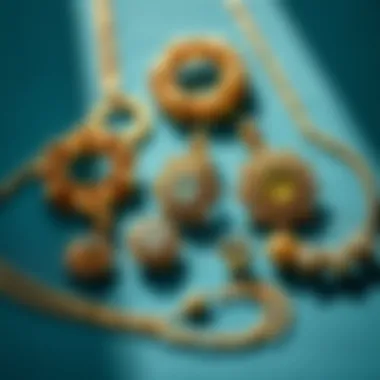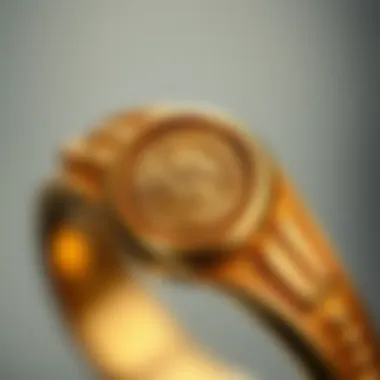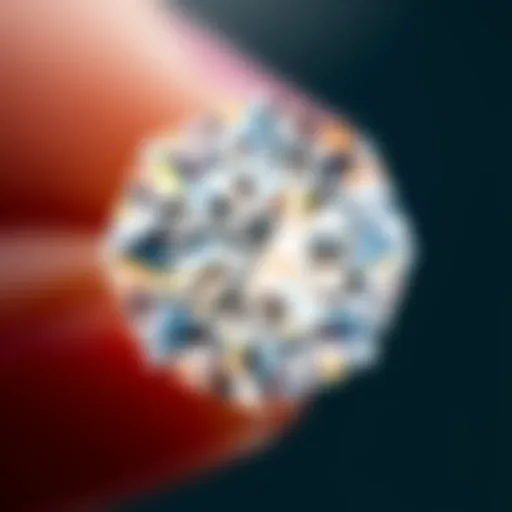Exploring Used Real Gold Jewelry: A Comprehensive Guide


Intro
Gold jewelry has resonated with human civilization through the ages, often embodying wealth, social status, and artistic expression. The allure of used real gold jewelry extends beyond mere aesthetics; it encapsulates history, cultural significance, and economic value. As consumers become increasingly aware of sustainable practices, exploring the world of pre-owned gold jewelry is not just a trend but an evolving mindset.
In this comprehensive guide, we will navigate the intricate landscape of used real gold jewelry. We’ll dive into its significance across different contexts, factors impacting its valuation, and of course, the nuances of purchasing, caring for, and maintaining these precious pieces. Moreover, we’ll draw connections between historical perspectives and modern trends in the market. Whether you're an avid collector, a discerning buyer, or simply intrigued by the craftsmanship of gold, this article aims to provide you with invaluable insights.
We will also explore the eco-friendly aspect of recycling precious metals, aligning our appreciation of art with responsible consumerism. With that said, let’s jump into the golden world that awaits us.
Prelude to Used Real Gold Jewelry
Used real gold jewelry holds a special place in the hearts of many. It is not just about the material; it carries stories, memories, and often significant value. Understanding the nuances of used gold jewelry opens up a world of opportunities for gemstone enthusiasts, collectors, and jewelry designers alike. This guide aims to shed light on the importance of this topic and how it can impact your appreciation and involvement in jewelry.
Defining Used Real Gold Jewelry
When we talk about used real gold jewelry, we refer to pieces that have previously been owned and worn. These items can range from vintage heirlooms to more contemporary fashion pieces. The defining feature is the gold content itself, usually measured in karats. Understanding this definition is crucial, as it influences everything from valuation to selection when buying or selling jewelry.
The Historical Context of Gold Jewelry
Cultural Significance
Gold jewelry has been a staple in various cultures throughout history. In ancient Egypt, it represented wealth and was often used in burial rites for pharaohs. Gold pieces adorned the tombs of kings, showcasing their power and status even in the afterlife. This cultural significance reflects a broader view of how societies perceive value, making it a fascinating subject for collectors and historians. Gold jewelry’s historical context contributes richly to its allure in today’s market, as it embodies craftsmanship and tradition that many find appealing. It carries not just aesthetic value but also a deep historical narrative that can enhance one's appreciation of a piece.
Advantages of its cultural significance include:
- Investment in History: Owning such pieces connects buyers to the past.
- Aesthetic Appeal: Vintage items often possess unique charm and craftsmanship that modern pieces may lack.
Symbolism Across Societies
The symbolism of gold jewelry extends across continents and eras. In many cultures, gold symbolizes purity and eternal love. For instance, in Western cultures, gold rings are incorporated into wedding ceremonies, representing commitment and unity. In contrast, in Hindu culture, gold is associated with prosperity and is commonly given during festivals like Diwali. The symbolism across societies showcases how gold jewelry is both a personal and cultural statement.
The benefits of understanding this symbolism include:
- Deeper Connections: Knowing the meaning behind a piece can enhance its value to the owner.
- Cultural Importance: It allows collectors to engage with the nuances of their pieces, enriching their experience.
Gold jewelry, therefore, is more than merely adornment; it's a bridge connecting various cultures and histories. This understanding can inform purchasing decisions, as well as how pieces are cared for and handed down through generations.
"Every piece of gold jewelry has a story to tell, from the hands that crafted it to the hearts that wore it."
By exploring these facets of used real gold jewelry, enthusiasts can make informed choices, preserve traditions, and appreciate the beauty and significance that each piece carries.
The Market for Pre-Owned Gold Jewelry
The market for pre-owned gold jewelry is crucial in understanding the broader implications of buying and selling these timeless treasures. As trends shift towards sustainability and unique personal expressions, consumers increasingly turn to second-hand jewelry. This shift not only caters to individual tastes but also aligns with growing environmental consciousness, making the market for used gold jewelry both a significant economic sector and an ethical choice.
In this segment, we delve into the dynamics of this market, exploring how trends shape buying behaviors and what factors can influence the value of gold jewelry pieces.
Understanding Market Trends
Market trends in pre-owned gold jewelry are influenced by various factors, including consumer preferences, market conditions, and broader economic indicators. The popularity of vintage and antique styles has surged, as many individuals seek one-of-a-kind pieces that tell a story. As social media influences fashion trends, platforms like Instagram showcase unique jewelry items, encouraging consumers to seek out second-hand options to replicate those styles without breaking the bank.
Moreover, with increasing awareness about the impact of traditional mining practices on the environment, many are opting for pre-owned gold as a more sustainable alternative. As such, the eco-friendly movement has found its way into the jewelry market, making pre-owned options not just desirable from a style perspective, but also from an ethical one.
Factors Affecting the Value of Used Gold Jewelry
Several distinctive elements contribute to the valuation of used gold jewelry. Understanding these factors can help buyers make informed decisions when purchasing their next piece.
Craftsmanship
Craftsmanship plays a pivotal role in determining the value of used gold jewelry. Well-crafted pieces often feature intricate designs and quality materials, which can enhance their appeal and longevity. For instance, a handmade item may reflect the skills and creativity of an artisan, making it more desirable than mass-produced alternatives. The attention to detail can make a piece stand out not just as a jewelry item but as wearable art.
However, not all craftsmanship is equal. Some might find that vintage pieces with unique, notable designs fetch higher prices due to their history and artistry. A beautifully crafted brooch from the Art Deco era might hold more sentimental and monetary value than a similar piece produced in today's fast fashion world.
Provenance
Provenance, or the history of ownership of a piece, significantly contributes to its value in the pre-owned market. Jewelry with a notable backstory—perhaps it once belonged to a celebrity or was passed down through generations—often captures greater interest from collectors and enthusiasts alike. This narrative adds layers of meaning, making the piece more than just an accessory; it becomes a story waiting to be shared.


Nevertheless, not every piece has a clear lineage, which can impact its perceived worth. A report or documentation establishing its authenticity and previous ownership can greatly enhance value but is often hard to come by. As such, buyers need to do their due diligence to establish its history whenever possible.
Condition
Condition can eithr make or break the value of used gold jewelry. A piece that has been well-maintained will not only look better but will also likely retain more of its original market value. Signs of wear, such as scratches, tarnishing, or broken clasps, can greatly lower a piece's desirability. Moreover, pieces that receive regular maintenance, such as cleaning and repairs, can appear more appealing.
On the flip side, a used piece in excellent condition might command a premium price, especially if it features rare designs or stones. Buyers should pay close attention when buying used jewelry to ensure that they're not overspending on items that will need costly repairs or significant maintenance in the future.
In summary, recognizing the key factors affecting the value of used gold jewelry can empower consumers to navigate the pre-owned market wisely. The interplay between craftsmanship, provenance, and condition shapes what buyers might be willing to pay, and understanding these elements can lead to more rewarding acquisitions.
Evaluating Authenticity in Used Gold Jewelry
When it comes to the purchase of used real gold jewelry, verifying authenticity is paramount. It not only ensures that you are receiving a genuine product but also safeguards your investment. In a world where counterfeit items can easily be mistaken for the real deal, understanding how to evaluate the authenticity of gold jewelry is essential for every enthusiast.
Hallmarks and Certification
Hallmarks serve as a stamp of credibility on pieces of gold jewelry. These small yet significant markings indicate the purity and karat value of the gold. Typically, these hallmarks are found on the inside of rings or in hidden places on other types of jewelry.
A hallmark can be a symbol, a number, or even a combination of both, representing the gold's integrity. For instance, a piece marked with “14K” signifies that the item is composed of 58.3% pure gold, while “18K” indicates 75% purity. Furthermore, hallmarks can contain information about the jeweler or manufacturer, providing provenance that can further enhance the jewelry's value. Sometimes, certifications from recognized entities can complement these hallmarks, adding an extra layer of security for buyers.
Understanding these markings is not just a matter of knowledge; it instills confidence in the purchaser. A thorough check for hallmarks can help buyers avoid potential pitfalls, ensuring they’re not falling for something that’s just pretty plating over lesser metals.
Testing Techniques for Verification
When hallmarks are absent or unclear, further testing techniques become crucial to ensuring that a piece is authentic.
Acid Tests
Acid tests are a common method to verify the authenticity of gold jewelry. This procedure involves applying a small amount of acid to the jewelry and observing the reaction. Different acids correspond to different karat levels of gold, which allows the tester to determine the purity of the piece in question.
The key characteristic of acid tests lies in their simplicity. They can be performed with minimal equipment and are relatively inexpensive, which makes them a popular choice among buyers and sellers alike. However, one unique feature of acid tests is the potential risk of damaging the piece; a small scratch is usually needed to expose a fresh surface for testing. Therefore, buyers should weigh this disadvantage carefully, ensuring they are comfortable with the possible repercussions before applying acid to their jewelry.
Electronic Testing
Electronic testing presents a modern take on authenticity verification, leveraging technology to provide quick results. This method utilizes a probe that measures the electrical conductivity of gold. Different karat levels have distinct conductivity readings, allowing the tester to ascertain the purity of the metal.
The primary advantage of electronic testing is that it does not require any physical alteration to the jewelry, thus preserving its condition. This makes it especially appealing for high-value items where integrity is paramount. However, its limitation lies in potential inaccuracies if the jewelry has been over-polished or contains other alloys that can skew the readings.
For further insight into jewelry authenticity, consider visiting reliable sources like Wikipedia or Britannica.
"A discerning buyer is a wise buyer. Always prioritize authenticity over aesthetics."
Buying Used Real Gold Jewelry: Essential Tips
When it comes to investing in used real gold jewelry, understanding the nuances of the buying process is crucial. The world of pre-owned jewelry is vast, riddled with opportunities and potential pitfalls. Thus, this section delves into where to buy and how to negotiate effectively. Knowledge here can not only save you money but also position you to make sound investments.
Where to Buy: Trusted Sources
Finding the right place to buy gold jewelry may feel daunting at first. However, breaking it down into three main sources can simplifying decision-making:
Pawn Shops
Pawn shops can sometimes be hidden gems when it comes to buying used gold jewelry. They often offer a range of jewelry, from vintage pieces to contemporary designs at prices that may surprise you.
One key characteristic of pawn shops is their negotiation culture. Most shop owners expect some degree of haggling, meaning there’s often wiggle room on price. Dealers here are usually looking to sell someone’s pre-owned jewelry quickly, rather than holding onto it for the long-term, which can be to your advantage.
However, while shopping at a pawn shop can yield good deals, do mind that the variety can be hit or miss. Take the time to inspect items thoroughly, and verify their authenticity before making any purchases. Remember, always check for gold markings and try to get a sense of the item's history.
Online Marketplaces
In the modern shopping landscape, online marketplaces like eBay or Etsy provide vast selections and convenience. Here, buyers can browse thousands of listings from the comfort of their own homes.
The appealing aspect of online marketplaces is the sheer diversity of choices. You can find anything from unique, handcrafted pieces to more mainstream designs. Additionally, user reviews and seller ratings provide an added layer of reassurance regarding quality and authenticity. If you’re keen on a particular style or era, chances are you’ll find it here.
Nonetheless, it’s crucial to exercise caution. Scams are unfortunately prevalent in online venues, and not every seller has your best interest at heart. Always read descriptions carefully, and when possible, buy from sellers that offer return policies. It’s worth reaching out to sellers with any clarifying questions to ensure you make the right choice.
Artisan Shops


For those looking to find something special, artisan shops offer a chance to pick up unique pieces directly from craftsmen. These shops emphasize handmade, often one-of-a-kind jewelry, allowing for an intimate shopping experience. The stories behind these pieces can be just as captivating as the jewelry itself.
What sets artisan shops apart is their attention to detail and craftsmanship. Each piece usually comes with a narrative—be it the artistry of its maker or the materials used. Buying from an artisan not only benefits the creator but also brings home a unique story.
On the downside, such pieces might carry higher price tags given the artistry involved. However, for many, the investment goes beyond the monetary aspect to the value of owning something distinct and meaningful.
"The right jewelry should evoke emotions, and each piece has a story waiting to be shared."
Negotiation Techniques for Buyers
As you dip your toes into the world of used gold jewelry, sharpening your negotiation skills can lead to significant savings. Understanding that negotiation isn’t merely about squeezing the last dollar from a seller is paramount. It's about creating a mutually beneficial deal.
To hone this skill:
- Do Your Homework: Knowing the market value of the jewelry in question gives you a solid foundation. Being aware of recent sales or similar pieces can strengthen your position.
- Be Polite and Respectful: Forming a good rapport can positively affect negotiations. A friendly demeanor often leads sellers to be more accommodating.
- Timing Is Key: Auctions or clearance sales usually present ample opportunity to negotiate, especially if items haven't sold over time.
- Walk Away If Necessary: Sometimes, the best tactic is knowing when to walk away. Making it clear you’re willing to consider other options can create urgency for the seller.
Employing these techniques will not only improve your purchase outcomes but may also help to foster relationships with sellers for future endeavors.
Caring for and Maintaining Used Gold Jewelry
Taking care of and maintaining used gold jewelry is a crucial aspect that often goes overlooked. Just like any valuable item, these pieces require regular attention to sustain their beauty and functional integrity. Understanding how to properly care for your gold jewelry can enhance its lifespan and preserve its value over time. Not only does proper maintenance ensure the jewelry retains its shimmering appeal, but it also protects against unexpected damages, which can be costly to fix.
Furthermore, with the increasing concerns about sustainability within the jewelry industry, caring for gold pieces can extend their lifecycle—an environmentally-friendly aspect much appreciated today. Therefore, understanding the specific practices for daily care and long-term storage is essential for any jewelry lover.
Daily Care Practices
Taking minimal time each day to care for your gold jewelry can yield significant benefits. Here are a few recommended daily care practices:
- Gentle Cleaning: Use a soft cloth to wipe your jewelry after each use. This helps remove natural oils, dirt, and sweat, which can dull gold's shine.
- Avoid Exposure to Chemicals: Gold is a sensitive metal and can react poorly to lotions, perfumes, and cleaning agents. Always put your jewelry on after applying these products and take it off before using harsh chemicals.
- Check for Damage: Regularly inspect your pieces for signs of wear and tear, such as loose stones or broken clasps. Addressing these issues promptly can prevent larger problems in the future.
By following these simple daily habits, you can ensure that your used gold jewelry continues to sparkle as brightly as the day you bought it.
Long-Term Storage Solutions
When it comes to maintaining the condition of your used gold jewelry, proper long-term storage practices are just as important. Here are some effective strategies to keep your pieces safe and well-preserved:
- Use a Jewelry Box: Store your gold jewelry in a dedicated jewelry box to prevent scratches. Opt for a box with a soft lining to cushion the pieces.
- Individual Pouches or Bags: If you have multiple pieces, consider placing them in individual pouches. This helps avoid tangling and minimizes scratching.
- Keep Away from Humidity: Store your jewelry in a cool, dry place. Excess humidity can lead to tarnishing, even in gold jewelry. Sealable plastic bags can offer an extra layer of protection against moisture.
In summary, both daily and long-term care are vital for ensuring that your used gold jewelry remains in prime condition. With a little dedication and awareness about how to properly care for these valuable pieces, you are not only cherishing their beauty but also honoring their resilience and history.
The Environmental Impact of Used Gold Jewelry
When discussing used real gold jewelry, an often overlooked aspect is its environmental impact, which is significant for a variety of reasons. The journey of gold sourcing traditionally involves extensive ecological disruption, from mining practices that disturb vast ecosystems to water usage that depletes vital resources. In this section, we’ll delve into sustainability in jewelry making and the implications of recycling gold to better understand how used gold jewelry can align with environmental mindfulness.
Sustainability in Jewelry Making
Sustainability in the jewelry industry is not just a passing trend; it’s becoming a fundamental component of the entire production process. Jewelry makers and consumers alike have started to awaken to the detrimental effects of traditional gold mining methods. Here are some key elements that define sustainable practices in jewelry making:
- Ethically Sourced Materials: Many artisans are moving towards sourcing gold from recycled sources or from mines that maintain environmentally sound practices. This shift fosters an eco-conscious narrative, allowing consumers to wear pieces that align with their ethical values.
- Eco-Friendly Manufacturing: Techniques such as using hand tools and renewable energy sources in workshops minimize carbon footprints. Additionally, choosing sustainable packaging can further contribute to reducing the overall environmental impact of a piece of jewelry.
- Longevity of Pieces: Sustainable jewelry often emphasizes creating timeless designs that don’t fall out of fashion, encouraging consumers to value each piece rather than constantly replace them.
The effectiveness of these practices largely hinges on an awareness of the entire lifecycle of jewelry, from conception to rings on fingers. When individuals opt for used real gold jewelry, they not only appreciate its beauty but also partake in a responsible movement toward sustainability.
Recycling Gold: Implications and Benefits
Recycling gold holds numerous benefits, both environmentally and economically. Here are some important points to consider:
- Reduction in Mining Demand: Recycling existing gold mitigates the need for new mining operations. This, in turn, conserves natural habitats and prevents the destruction of ecosystems. As gold can be recycled infinitely without losing its properties, this presents a massive opportunity for the jewelry industry to become more sustainable.
- Lower Energy Consumption: The recycling of gold requires significantly less energy compared to mining new gold. Estimates suggest that recycling gold can use up to 90% less energy. This decrease is important in the fight against climate change, as less energy consumption leads to lower greenhouse gas emissions.
- Economic Benefits: Recycled gold can maintain or even increase in value, depending on market conditions. Investors who focus on upcycled jewelry often see it as a hedge against declining new gold resource availability.
"Recycling gold not only saves the planet but also preserves value for future generations."
This isn’t just an industry trend; it’s a shift that directly influences consumer behavior and preferences. By opting for used gold jewelry, individuals help address some of the critical challenges posed by gold mining, such as habitat destruction and toxic runoff.
Design Trends in Used Gold Jewelry
In the realm of jewelry, design trends hold immense importance. They whisper tales of culture, history, and evolving tastes. Used gold jewelry is no exception. As adoption of sustainable practices grows, appreciating the design nuances and trends in pre-owned gold pieces becomes significantly relevant. The link between the past and present is woven through the very metals that adorn us. Contemporary designs often pay homage to vintage styles, creating a rich tapestry of aesthetics that appeals to newer generations while honoring timeless craftsmanship.


Vintage Styles and Their Revival
Vintage styles are all the rage nowadays. When you think of vintage, you often picture ornate designs and intricate patterns, don’t you? Such pieces often echo the artistry of earlier eras. This revival connects us with our heritage, allowing wearers to don unique pieces that tell stories of different times. For instance, art deco designs with their geometric shapes continue to fascinate many, while Victorian pieces appeal with their romantic details.
Moreover, from a market perspective, these vintage jewels can be quite the treasure trove. They often appreciate in value over time, making them attractive not just from a style standpoint but also an investment one. Collectors often seek specific eras or styles, creating niches that can drive the price upward. It’s like having a slice of history wrapped around your neck!
Here’s a list to consider when exploring vintage styles:
- Look for hallmark stamps; they provide clues about age and origin.
- Pay attention to material quality; the better the condition, the higher the value.
- You might want to explore local antique stores or online platforms specializing in vintage jewelry.
- Unique features like original box or papers can add value as well.
Contemporary Designs Incorporating Used Gold
The modern landscape of jewelry design is a glorious blend of innovation and tradition. Several contemporary designers are now embracing used gold to create stunning pieces that resonate with ethical values. Not only do these designs look spectacular, but they also carry a story with them—each piece is steeped in history while being reshaped into something novel and vibrant.
Today's designers often incorporate mixed materials into their work, blending used gold with silver, gemstones, or even sustainable materials. Such combinations not only enhance the visual appeal but also make for more eco-friendly choices. When you wear one of these pieces, you’re not just wearing a jewel; you’re showcasing a commitment to sustainable practices—one that speaks volumes in a world striving for eco-conscious living.
Consider checking the following when engaging with contemporary designs:
- Look for certifications that indicate recycled materials are used.
- Research collections from designers who focus on sustainable practices; many are evident on platforms like Etsy.
- Consider custom designs—many jewelers are willing to incorporate your ideas, giving a unique twist to your piece.
"Jewelry is like the perfect spice. It always complements what's already there." – Diane Von Furstenberg
In closing, the designing evolution of used gold jewelry reflects societal values and taste evolutions. Whether it's reviving vintage looks or embracing contemporary innovations, each piece carries its weight as an investment, both in value and history. As we navigate through the infinite styles available, the decision to choose used gold jewelry ultimately becomes a celebration of individuality and sustainable choice.
Investment Potential of Used Real Gold Jewelry
The allure of used real gold jewelry extends beyond its aesthetic charm; it also presents a significant investment opportunity. Investing in pre-owned gold jewelry can be a wise strategy for those looking to diversify their asset portfolio. The intrinsic value of gold itself has stood the test of time, often serving as a hedge against inflation and economic uncertainty. As such, understanding the investment potential of used real gold jewelry is crucial for both collectors and investors alike.
Long-Term Appreciation Trends
Gold has a reputation for appreciating over long periods. Historically, the value of gold jewelry tends to rise, reflecting not just the commodity's market value but also the craftsmanship and artistry involved in creating unique pieces. Unlike stocks or bonds, gold does not provide dividends, but its value is rooted in demand and rarity.
Some trends worth noting include:
- Economic Fluctuations: When economies falter, investors flock to gold, pushing prices higher. In recent years, spikes in gold prices were observed during economic downturns, making it a go-to for those seeking stability.
- Cultural Resurgence: Interest in vintage styles has surged. The revival of retro designs from past decades boosts demand for certain types of gold jewelry that are seen as both fashionable and collectible.
- Technological Advancements: With better recycling methods and more efficient mining processes, the availability of gold remains relatively stable, which can impact long-term pricing in unpredictable ways.
In the long run, savvy investors take note of these trends, assessing which pieces might appreciate the most based on factors including age, design, and condition.
Market Risks and Considerations
While the investment potential of used gold jewelry is substantial, it is not without its risks and considerations. Here are some factors to keep in mind:
- Market Volatility: The gold market is subject to fluctuations. Prices can jump or plunge based on geopolitical events, changes in monetary policy, or shifts in consumer demand.
- Authenticity Concerns: The used jewelry market can be rife with imitations and altered pieces. Ensuring the authenticity of gold jewelry before purchasing is vital for safeguarding your investment.
- Emotional Value vs. Market Value: Many pieces of jewelry carry sentimental value that may not be reflected in their market price. When buying for investment, it's essential to distinguish between emotional attachments and economic value.
"Investing in gold jewelry requires a delicate balance between appreciation potential and inherent market risks. Like all investments, thorough research is key."
For additional insights on the market dynamics of gold investing, you may explore resources like Investopedia or Kitco.
Understanding these aspects of investing can enhance your approach to acquiring used gold jewelry, perhaps turning an initial passion into a successful financial asset.
Epilogue: The Enduring Appeal of Used Gold Jewelry
As we've explored, used real gold jewelry carries a weight that transcends mere aesthetics or monetary value. The enduring appeal of these pieces is drawn from a tapestry of historical, cultural, and individual narratives. Each item tells a story, serving as a bridge connecting generations—filling the gaps in our past while reflecting our present.
Gold has been revered for centuries, often regarded as a symbol of wealth and status across different cultures. Today, buying used real gold jewelry is not just about acquisition; it's about honoring craftsmanship and preserving tradition. The conscious choice to purchase pre-owned jewelry is also a testament to sustainability, as it reduces the environmental impact associated with mining new gold.
Significance of Investing in Used Gold Jewelry
When considering the investment potential, used gold jewelry is often looked at as a stable asset. Unlike fluctuating stocks or cryptocurrencies, gold exhibits a historical trend of value appreciation over time. This characteristic is recognized by collectors and investors alike. Factors such as craftsmanship, provenance, and condition can elevate an item's worth, creating an opportunity for savvy buyers to both own a unique piece and secure a financial asset.
As with any investment, understanding market trends is essential. Keeping an eye on economic forecasts and consumer interest in vintage items can guide purchasing decisions.
Personal Connection and Sentimental Value
Beyond investment, the personal connection to used gold jewelry cannot be understated. A piece from a grandmother or a unique find from a market can symbolize love and memory. Individuals often wear these items not just as ornaments but as cherished heirlooms. This emotional layer adds depth to the appeal and can transform an ordinary item into a treasured keepsake.
Considerations for the Future
While trends and tastes in jewelry will ebb and flow, the intrinsic value of gold remains steadfast. Its ability to outlast fashions, during both economic high and low times, underscores why many consider it a wise choice for investment and personal use. Furthermore, as consumers grow more environmentally aware, the shift toward used goods reflects an evolving mindset that celebrates resourcefulness and history.
"Gold is a treasure with stories that transcend time; each piece carries whispers of the past while shining brightly in the present."
For further reading on gold's significance and market trends, refer to resources such as Wikipedia and Britannica. Join communities discussing used gold jewelry on platforms like Reddit to share insights and findings with fellow enthusiasts.







